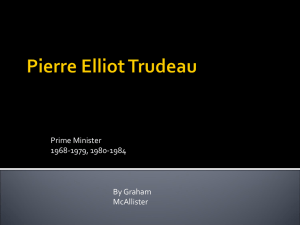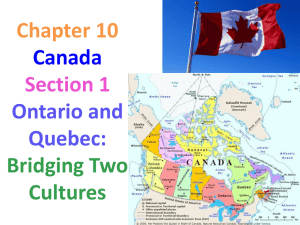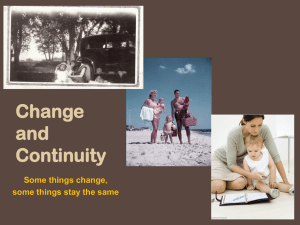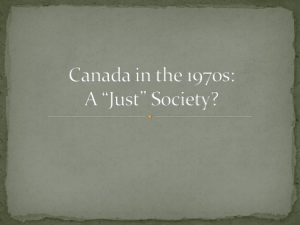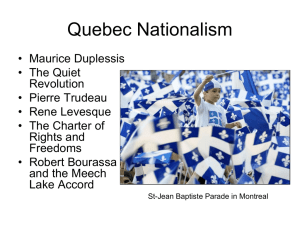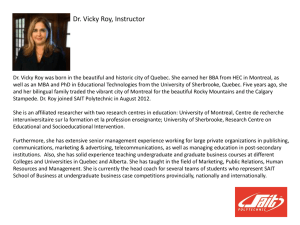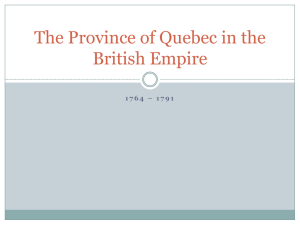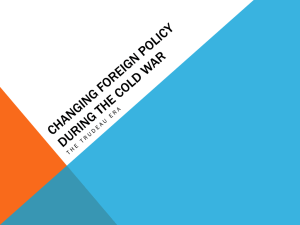Canada in the 80`s and 90`s Due
advertisement
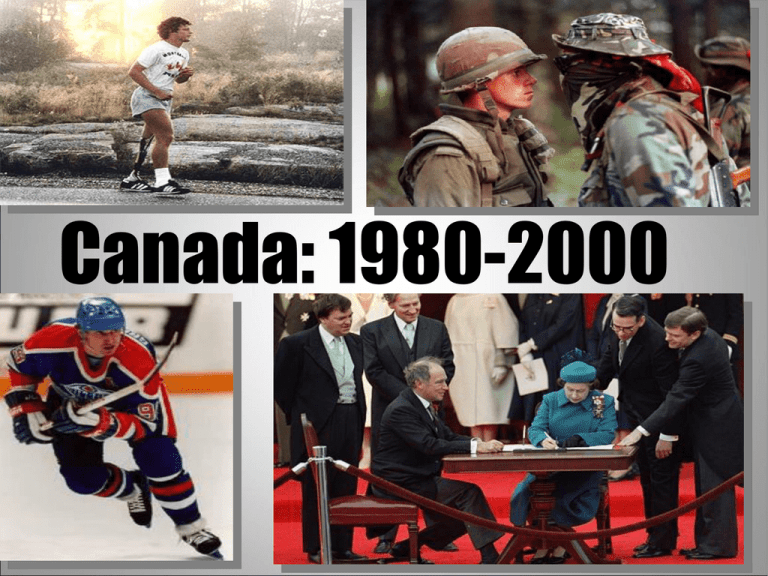
Canada: 1980-2000 “Well, welcome to the 1980s” ● ● With these words, Pierre Elliot Trudeau celebrates his political comeback as Prime Minister after winning a majority Liberal government in the February, 1980 election. Although he had been Prime Minister since 1968 (except for Conservative Prime Minister Joe Clark's threemonth minority government in 1979), his next four years in power would define Canada for decades to come. ● Fuddle Duddle, as Coined by Pierre Trudeau ● It will make sense when you watch it. 1980: The National Energy Program ● ● ● One of Trudeau's first actions after the election was to bring in the National Energy Program. The NEP was designed to protect Canada's oil supply and promote Canadian ownership of our energy resources. Petro-Canada was created as a national oil and gas company. The NEP made Alberta's oil and gas available at cheaper than world prices to Canadian manufacturing companies, especially in eastern Canada, and further taxed oil and gas profits. In protest, Alberta's Premier Peter Lougheed threatened to cut oil shipments to eastern Canada. Prices were raised to reflect world prices but the NEP remained in place until 1984. It became a symbol of the rising feeling of Western Canadian Alienation, as Western Canadians felt taken for granted and pushed around by a federal government more focussed on 1980: “Oui ou Non”: The Quebec Referendum ● ● ● ● May 20, 1980, Quebec Premier René Lévesque holds a referendum to separate Quebec from Canada. Levesque in 1964 59.6% voted against separation, while only 40.4% voted for it. In his speeches against separation, Prime Minister Trudeau promises a new constitutional agreement with Quebec. After much political wrangling, Trudeau succeeds in bringing Canada's Constitution, the British North America Act of 1867, home to Canada from Britain. Bringing home the constitution Levesque opposes the constitutional changes and Quebec refuses to sign the agreement which becomes law anyway. Levesque on the constitution 1982 Patriation of the Constitution ● ● ● “Today I have proclaimed this new Constitution, one that is truly Canadian at last. There could be no better moment for me as Queen of Canada to declare again my unbounded confidence in the future of this wonderful country.” -Queen Elizabeth at the proclamation ceremony, April 17, 1982. Patriation is a legal term made up in Canada to mean taking control of our constitution from Great Britain. The British North America Act of 1867 was revised and became the Constitution Act of 1982. . Canada had gained its independence as a country. The Charter of Rights and Freedoms ● ● ● The new Constitution Act included an entrenched Charter of Rights and Freedoms which protects political, civil and minority rights in Canada. Entrenched is a legal term meaning that it can only be changed through a nation-wide amendment process, the same amendment process needed to change the Constitution Act. Amendments to the Constitution Act can only be passed if agreed to by 7 provinces totalling more than 50% of Canada's population. The 1981-1984 Recession ● ● ● ● From 1981 to 1984, Canada's economy experienced its worst downturn since the Great Depression, with interest rates climbing to 23%, and more than 1.5 million Canadians out of work. Because of government spending to try to turn around the recession, and because of the high interest rates, the federal government debt tripled from $84 Billion in 1981 to $240 Billion in 1986. It is now at just under $500 Billion. The debt rise led to government cutbacks in social programs such as unemployment insurance and welfare that continues to this day. The recession was the end of decades of unhindered prosperity and growth for Canada, and poverty, unemployment and homelessness increased. Similar to the Depression of the 1930s, food banks became a normal fact of life for some families, rather than an emergency measure. 1984: Canada shifts right ● Pierre Trudeau retired in February, 1984, and John Turner replaced him as liberal leader and Prime Minister. Turner called an election and faced off against the new Progressive Conservative leader, Brian Mulroney. Mulroney's victory was partly due to his crushing win over Turner in a televised debate. ● Mulroney received unprecedented support from Quebec and he promised to make a constitutional deal which Quebec would support. ● Mulroney's economic policies aimed at taming the debt with cuts to social programs and public spending, a right-wing position described as “neo-conservatism”. ● ● Trudeau's First Resignation Bonus marks to anyone who can stay awake for all of this. Constitutional Talks: Meech Lake 1987-1990 ● ● ● ● Mulroney's first attempt to bring Quebec to the table was the 1987 Meech lake Accord. All ten provincial premiers, including Quebec's Robert Bourassa, agreed to the accord, which recognized Quebec as a 'distinct society', and increased provincial powers. Provinces had three years to ratify, or vote for, the agreement in their legislatures. Opposition rose across Canada, arguing that agreement would weaken the federal government, and it would give Quebec a special status that would be resented by the rest of Canada. Elijah Harper, a Manitoba MLA, refused to vote for the Accord because it did not guarantee rights for First Nations peoples. Because of his stand, Manitoba couldn't get the unanimous agreement it needed to pass it. When Newfoundland also refused to ratify the agreement, it failed in 1990. Elijah Harper Meech Lake Constitution Again: Charlottetown 1992 ● ● ● ● Quebec's anger over the failure of Meech resulted in a dramatic rise in separatism in the province. Mulroney tried again to bring Quebec aboard with the Charlottetown Accord of 1992. Similar to Meech, the Accord weakened federal authority and increased provincial powers in many areas. Quebec's 'distinct society' was again recognized, and this time aboriginal leaders were invited to the discussions. Opposition to the Accord showed how divided Canada had become. Preston Manning and the Reform Party, the new Western Canadian protest party were against it, and the hardcore separatists in Quebec also opposed it. Former Prime Minister Trudeau said it would destroy Canada. A national referendum resulted in a “No” vote of 54.3%, and the Charlottetown Accord failed. Charlottetown 1988: The Free Trade Agreement ● ● ● ● In 1988, Canada negotiated and signed a free trade agreement with the United States. Under the U.S.-Canada agreement, trade was made easier, and there were no tariffs on goods traded between the two countries. In the negotiations, Canada was able to protect its culture from U.S. control, and water resources were kept off the table as well. On the plus side, Canadian exports to the U.S. rose, but the U.S. has not always lived up to the spirit of the agreement on such issues as softwood lumber tariffs. In 1994, Mexico joined the agreement which is now called NAFTA, the North American Free Trade Agreement. The G.S.T. and the Fall of Mulroney ● ● ● In 1991, the government introduced the Goods and Services Tax (G.S.T.), a 7% sales tax. Although the tax replaced a hidden tax on manufactured goods that had long existed, the fact that shoppers could now see the tax at the check-out counter made it an unpopular one. By 1993, when Mulroney would have had to call an election, his popularity had dropped to the lowest of any Prime Minister ever measured by polls. He resigned as Prime Minister, and the Progressive Conservative leadership was won by Kim Campbell, who became Canada's first female Prime Minister. Campbell called an election, but with the loss of the West to the new Reform Party, and the loss of Quebec to the separatist federal party, the Bloc Quebecois, the Progressive Conservatives went from 169 seats to just two seats in the House of Commons. Liberal leader Jean Chretien was elected Prime Minister and would remain P.M. for the next ten years. 1995: Quebec again on the brink ● ● ● ● "Do you agree that Quebec should become sovereign after having made a formal offer to Canada for a new economic and political partnership within the scope of the bill respecting the future of Quebec and of the agreement signed on June 12, 1995?" In 1995, the Parti Quebecois again held a referendum on the separation of Quebec. Their complicated ballot question asked for Quebec to become an independent country with “sovereignty association”, or a mutual partnership, with Canada. Referendum Prime Minister Jean Chretien's Liberal government argued that Quebec would be cut off from Canada and ruined economically. Meanwhile, First Nations groups, notably the James Bay Cree which controlled huge areas of northern Quebec, stated they would remain with Canada if Quebec separated. The vote on October 30, 1995 was very close, with 50.58% voting No and 49.42% voting Yes. Canadians in Bosnia 1992 ● Canada was a significant contributor to the NATO mission in Bosnia-Herzegovina known as the Stabilization Force, or SFOR. Canadian troops first came to the Balkans in February 1992 as part of the United Nations Protection Force (UNPROFOR), which was formed to protect noncombatants during the wars that tore apart the former Republic of Yugoslavia. With the signing on December 14, 1995, of the General Framework Agreement for Peace at Paris, after negotiations conducted at Dayton, Ohio, NATO entered BosniaHerzegovina with the 60,000-strong Implementation Force (IFOR) to ensure that the belligerent parties complied with its terms. Genocide in Rwanda 1994 ● Background: Belgium once controlled Rwanda. When Belgium authorities discovered (around 1959) that Tutsi leaders were lobbying for control, they encouraged the Hutus to rise up against the would-be Tutsi usurpers. This resulted in the massacre of tens of thousands of Tutsis, and power fell into the hands of the Hutus who gained independence 1962. Tutsis took refuge in Uganda and founded the Rwandan Patriotic Front In 1973, a coup d’etat organized by the Hutu extremist General Juvenal Habyarimana, overthrew the existing government. This dictator encouraged discrimination between the Hutus and the Tutsis. In 1990, violence broke out between Habyarimana's and RPF's armies. Rwandan Tutsis and moderate Hutus also became the targets of attacks by Habyarimana's forces. The conflict worsened after the death of Habyarimana in 1994. The massacre of Tutsis and moderate Hutus began. Peacekeepers who were assigned to the site to keep the peace led by Canadian General Roméo Dallaire found themselves powerless in the face of this all-out genocide taking place before their very eyes. Indeed, insufficient troops, coupled with a restricted mandate hampered the Peacekeepers; they could not intervene effectively despite the intense pressure applied to the UN by General Dallaire for more troops and equipment. In less than four months, the death toll reached one million, most of the victims being Tutsis and moderate Hutus. ● Photo Reel and song dedicated to the Rwanda Slaughter ● Be happy that the pictures are blurry The sad part is that the baby is still alive. Canada’s international role in land mine reduction • In 1996 , Canada challenged countries from around the world to sign a treaty banning the production and use of land mines. In 1997, 134 countries and organizations signed the treaty, known as the Ottawa Process. Since 1997, 20 million stockpiled landmines have been destroyed, and the # of countries producing land mines has dropped from 54 to 16 ● ● Landmine Victims raise money for landmine survivors. Cambodian Landmine survivors play volleyball in the World Series. Canadian Timeline, 1980 - 2000 ● ● 1980: – Pierre Trudeau (Liberal) wins federal election. – Quebec votes against separation in a referendum. – “O Canada” becomes National Anthem – National Energy Program created. 1981 – ● Terry Fox dies, 9 months after a return of his cancer ended his cross-country marathon to raise money for cancer research. 1982 – Constitution patriated. Charter of Rights introduced. – The Ocean Ranger oil platform sinks in a storm off the coast of Newfoundland. Canadian Timeline (2), 1980 - 2000 ● 1984: –Trudeau retires. John Turner wins Liberal leadership, becomes P.M., then loses federal election to Brian Mulroney (Progressive Conservatives). –Jeanne Sauvé, first female federal cabinet minister and first female speaker of the house, is named first female Governor General. –Marc ● 1985: – ● Bomb downs Canada-bound Air India Flight 182 in sea near Ireland. 329 passengers, including 279 Canadians, killed. 1986: – ● Garneau becomes the first Canadian in space. Expo '86 held in British Columbia 1987: – Reform Party, Western-Canadian political party, founded. Canadian Timeline (3), 1980 - 2000 ● ● 1988: – Brian Mulroney wins federal re-election on the issue of Free Trade with the U.S. – Calgary holds Winter Olympics. 1989: – U.S- Canada Free Trade Agreement begins. – Montreal Massacre: Dec. 6, gunman slays 14 women at a Montreal university. – I graduated from high school ● 1990: – Meech Lake Accord fails. – Stand-off between Mohawk First Nation and government in Oka. – 1991: – Canadian Forces take part in the first Gulf War against Iraq. ● Oka Crisis. Oka News Report Canadian Timeline (4), 1980 - 2000 ● ● ● 1992: – Cod fishery is shut down in the Atlantic region. – Charlottetown Accord fails in national referendum. – Toronto Blue Jays win the World Series. 1993 – Brian Mulroney resigns. Kim Campbell becomes leader of the Progressive Conservatives and first female Prime Minister, but is defeated by Jean Chretien in the federal election. – Canadian soldiers in Somalia charged with torture and murder of civilians. 1995: – Another Quebec referendum on separation. The NO vote squeaks a win to keep Quebec in Canada. Canadian Timeline (5), 1980 - 2000 ● 1996: – ● ● Nisga'a Land Claim Agreement completed, giving First Nation self-government of 2000 sq. km. in Nass River Valley. 1997: – Chretien wins re-election as Prime Minister in federal election that sends five political parties to Parliament. – Confederation Bridge to Prince Edward Island opens. 1999 – April 1, the territory of Nunavut is founded. – Wayne Gretzky (#99) retires from playing hockey. – Wayne Gretsky's Highlights
